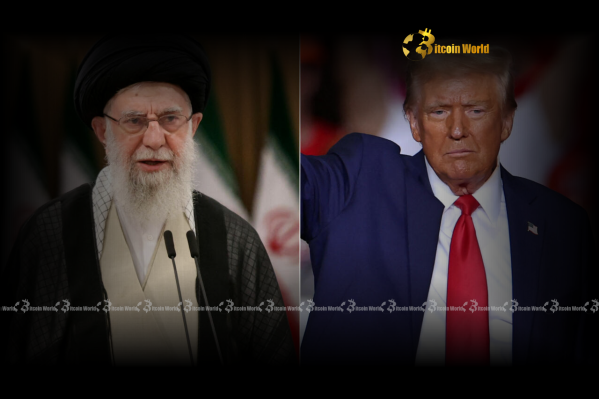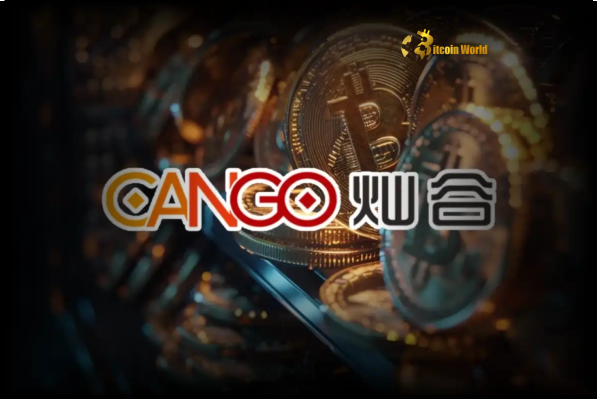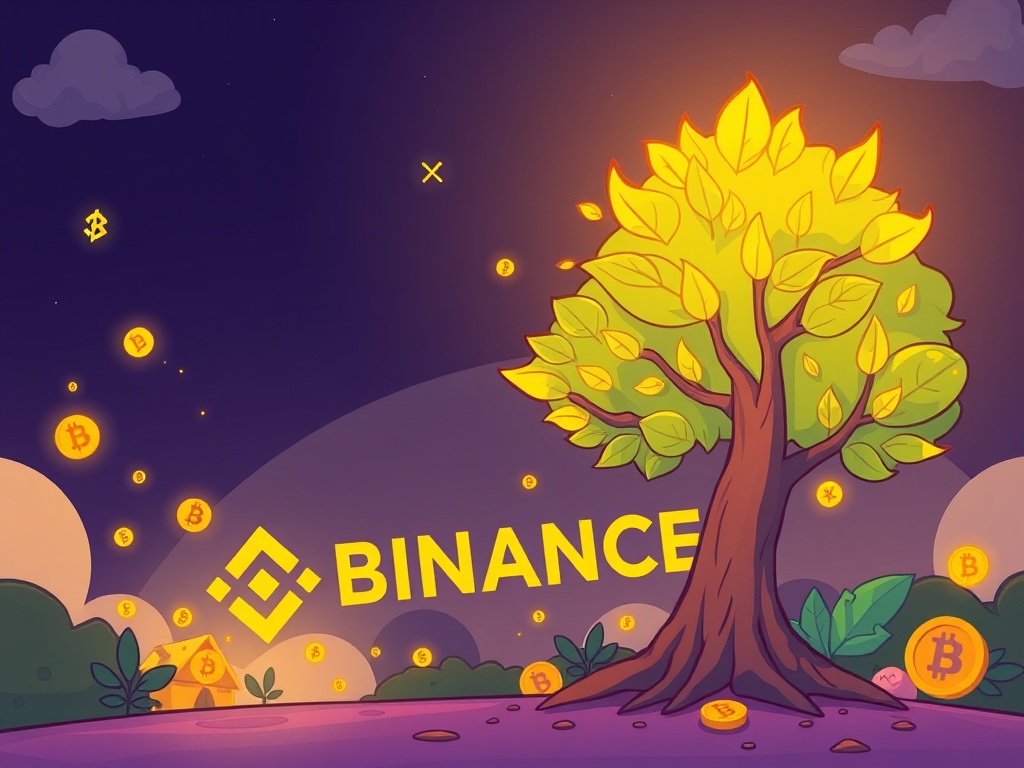BitcoinWorld

Iran Uranium Enrichment: Trump’s Crucial Warning and Global Repercussions
In the dynamic world of finance, where every ripple can become a wave, geopolitical events often cast long shadows. For those invested in cryptocurrencies, understanding these global shifts is paramount. A recent statement from former U.S. President Donald Trump regarding Iran uranium enrichment has sent a clear message, one that could significantly impact not just traditional markets but also the volatile crypto landscape. How might the threat of renewed conflict in the Middle East reshape investor sentiment and market trends?
Understanding the Warning: What Does “Another Strike” Mean for US Iran Relations?
During a press conference at the White House, former President Donald Trump issued a stern warning: if Iran attempts to enrich uranium again, the United States will consider another strike. This statement, initially reported by the Walter Bloomberg economic news account on X, immediately reignited discussions about the delicate and often volatile relationship between Washington and Tehran. The phrase “another strike” refers to previous military actions or threats of action taken by the U.S. against Iranian targets or proxies, particularly during Trump’s previous term.
The context of this warning is crucial. Iran’s nuclear program has been a point of international contention for decades. The 2015 Joint Comprehensive Plan of Action (JCPOA), often called the Iran nuclear deal, aimed to curb Iran’s nuclear ambitions in exchange for sanctions relief. However, the Trump administration withdrew from the JCPOA in 2018, re-imposing stringent sanctions. In response, Iran gradually scaled back its commitments under the deal, increasing its uranium enrichment levels and stockpiles beyond the limits set by the agreement. This escalation has been a constant source of tension.
When leaders speak of military action, even as a consideration, markets listen. For crypto investors, this isn’t just about geopolitics; it’s about potential shifts in market volatility, commodity prices, and investor flight to perceived safe havens. The implications of such a development can ripple through global economies, affecting everything from oil prices to supply chains, and ultimately influencing the broader financial ecosystem where digital assets operate.
The History of Iran Uranium Enrichment: A Persistent Global Concern
Iran’s pursuit of uranium enrichment has been a central element of its nuclear program and a primary concern for the international community. Uranium enrichment is a process that increases the concentration of uranium-235, the fissile isotope necessary for nuclear reactors and, at higher levels, nuclear weapons. Here’s a brief overview:
- Early 2000s: Iran’s clandestine enrichment activities were exposed, leading to international sanctions and diplomatic efforts.
- 2015 JCPOA: The landmark agreement limited Iran’s enrichment capacity, purity levels (to 3.67%), and stockpile size, ensuring a “breakout time” of at least a year for nuclear weapons development.
- 2018 U.S. Withdrawal: The Trump administration’s exit from the JCPOA and re-imposition of sanctions led Iran to gradually exceed the enrichment limits.
- Current Status: Iran has enriched uranium to levels far beyond the JCPOA limit, reaching 60% purity, a significant step closer to weapons-grade (90%). Its stockpile has also grown considerably.
Each step Iran takes in increasing its enrichment levels heightens concerns in Washington, Jerusalem, and Riyadh. The latest warning from Trump underscores the continued U.S. stance that such advancements are unacceptable and could provoke a military response. This situation creates a climate of uncertainty, which can be particularly unsettling for risk assets like cryptocurrencies, as investors often seek stability during times of crisis.
Navigating Strained US Iran Relations: A Tightrope Walk
The relationship between the United States and Iran has been fraught with tension for decades, marked by periods of confrontation and sporadic attempts at diplomacy. Trump’s recent statement is a reminder of the fragility of this dynamic. Key aspects of this strained relationship include:
- Sanctions Regime: The U.S. has maintained a robust sanctions program against Iran, targeting its oil exports, financial institutions, and key industries. These sanctions aim to pressure Iran to alter its nuclear program and regional behavior.
- Regional Proxy Conflicts: Both nations support opposing sides in various Middle Eastern conflicts, including in Yemen, Syria, and Iraq, leading to indirect confrontations.
- Direct Confrontations: Incidents like the 2020 assassination of Iranian General Qassem Soleimani by a U.S. drone strike and subsequent Iranian missile attacks on U.S. bases have brought the two nations to the brink of direct conflict.
- Nuclear Diplomacy Stalemate: Efforts to revive the JCPOA have largely stalled, leaving the nuclear issue unresolved and contributing to ongoing tensions.
The prospect of “another strike” by the U.S. would represent a significant escalation, potentially leading to a broader regional conflict. This uncertainty directly impacts global economic stability. When major powers are on the cusp of military engagement, the flow of goods, energy, and capital can be severely disrupted, creating ripple effects across all financial markets.
The Broader Impact: How Geopolitical Tensions Threaten Global Stability
When a major power like the United States issues warnings to a strategically important nation like Iran, the implications extend far beyond their immediate borders. Geopolitical tensions in the Middle East have a long history of impacting global affairs, particularly in the energy sector. A military confrontation could lead to:
- Oil Price Spikes: The Persian Gulf is a critical waterway for global oil shipments. Any disruption, perceived or real, can cause crude oil prices to surge, leading to higher energy costs worldwide.
- Shipping Lane Disruptions: The Strait of Hormuz, a narrow choke point at the mouth of the Persian Gulf, is vital for global trade. Threats to shipping in this area can disrupt supply chains and increase insurance costs, impacting everything from consumer goods to industrial components.
- Investor Uncertainty: Heightened tensions typically lead investors to pull funds from riskier assets and seek refuge in traditional safe havens like gold, the U.S. dollar, and government bonds. This shift can cause significant outflows from equity markets and, by extension, cryptocurrencies.
- Regional Destabilization: A conflict could draw in other regional actors, such as Israel and Saudi Arabia, potentially escalating into a wider Middle East war with devastating humanitarian and economic consequences.
The interconnectedness of the global economy means that even localized conflicts can have widespread effects. For the crypto market, which is still maturing and highly sensitive to external shocks, such developments can trigger sharp price movements and shifts in investor sentiment, contributing to market volatility.
Examining Global Economic Stability in the Face of Conflict
The potential for conflict between the U.S. and Iran poses a direct threat to global economic stability. The Middle East is a vital region for energy supply and international trade, making any instability there a concern for economies worldwide. Here’s how such tensions can manifest economically:
| Economic Indicator | Potential Impact of US-Iran Conflict |
|---|---|
| Oil Prices | Significant spikes due to supply concerns and geopolitical risk premium. |
| Inflation | Higher energy and shipping costs can fuel inflationary pressures globally. |
| Supply Chains | Disruptions to maritime routes and increased geopolitical risk can cause delays and higher costs. |
| Consumer Confidence | Decreased confidence due to economic uncertainty and potential conflict. |
| Interest Rates | Central banks might face pressure to adjust policies in response to inflation or economic slowdown. |
Beyond these immediate impacts, prolonged instability can deter foreign direct investment, hinder economic growth, and divert resources towards military spending, away from productive sectors. For an emerging asset class like cryptocurrencies, which often thrive on a stable and growing global economy, such disruptions can pose significant headwinds.
How Does This Affect Market Volatility and Crypto?
The potential for renewed U.S.-Iran conflict directly contributes to market volatility across all asset classes, including cryptocurrencies. While crypto markets are often influenced by their own unique drivers, they are not immune to broader macroeconomic and geopolitical currents.
Here’s how heightened geopolitical risk can impact crypto:
- Risk-Off Sentiment: During times of global uncertainty, investors tend to move away from riskier assets, including stocks and cryptocurrencies, towards perceived safe havens. This can lead to significant sell-offs in the crypto market.
- Correlation with Traditional Markets: While cryptocurrencies were once thought to be uncorrelated with traditional markets, recent trends show an increasing correlation, especially with tech stocks. If equities suffer due to geopolitical events, crypto often follows suit.
- Impact on Stablecoins: While stablecoins aim for price stability, extreme market conditions can test their peg, and their underlying reserves can be affected by broader economic downturns.
- Bitcoin as Digital Gold? Some proponents argue Bitcoin acts as a digital safe haven, similar to gold, during crises. While it has shown some characteristics of this in certain scenarios, its relatively young age and high volatility mean it’s not a guaranteed safe haven for all investors. Its price action during geopolitical crises can be unpredictable, sometimes rising, sometimes falling with broader market sentiment.
- Regulatory Scrutiny: Periods of global instability can also prompt increased scrutiny from regulators regarding capital flows and financial stability, potentially impacting the crypto industry.
Investors in digital assets must remain vigilant, understanding that external geopolitical factors can exert considerable pressure on prices and sentiment. Diversification and careful risk management become even more critical during such times.
Actionable Insights for Navigating Uncertainty
In a world where geopolitical statements can send ripples through global markets, what can investors, especially those in the crypto space, do to prepare?
- Stay Informed: Follow reliable news sources for updates on geopolitical developments. Understanding the nuances of situations like Iran uranium enrichment and US Iran relations is crucial.
- Assess Your Risk Tolerance: Before making any investment decisions, honestly evaluate your comfort level with potential losses. Geopolitical events can lead to rapid and unpredictable market swings.
- Diversify Your Portfolio: Do not put all your eggs in one basket. While crypto offers exciting opportunities, a diversified portfolio across different asset classes (including traditional assets) can help mitigate risks during periods of market volatility.
- Consider Stablecoins and Fiat: During extreme uncertainty, temporarily moving a portion of your crypto holdings into stablecoins or even fiat currency can be a strategy to preserve capital.
- Long-Term Perspective: Avoid making rash decisions based on short-term news cycles. If your investment thesis is strong for the long term, temporary dips due to geopolitical events might present buying opportunities for those with a high risk tolerance.
- Understand Correlations: Be aware of how crypto markets correlate with traditional markets during crises. Sometimes they move together, sometimes they diverge.
These insights are not financial advice but general guidelines to help investors approach a complex and uncertain global landscape with greater awareness.
A Compelling Summary: The Enduring Shadow of Geopolitics
Donald Trump’s warning regarding Iran uranium enrichment serves as a potent reminder that geopolitical events hold significant sway over global economic stability and financial markets. The intricate dance of US Iran relations, fueled by historical grievances and strategic imperatives, continues to be a major source of geopolitical tensions. While the immediate outcome of Trump’s statement remains to be seen, the underlying threat of conflict casts a long shadow, contributing to pervasive market volatility across the globe.
For cryptocurrency investors, this means maintaining a heightened sense of awareness. The digital asset space, while innovative and disruptive, is increasingly intertwined with the broader macroeconomic environment. Understanding how global events, from political rhetoric to potential military actions, can impact investor sentiment and capital flows is no longer optional but essential. As the world grapples with complex international relations, vigilance, informed decision-making, and a strategic approach to risk management will be key for navigating the turbulent waters ahead.
To learn more about the latest geopolitical tensions and their impact on global markets, explore our article on key developments shaping market volatility and investment strategies.
This post Iran Uranium Enrichment: Trump’s Crucial Warning and Global Repercussions first appeared on BitcoinWorld and is written by Editorial Team





